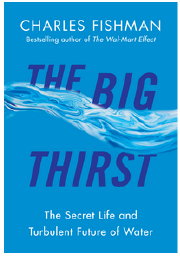Charles Fishman on the ‘Silent Revolution’ in Water Use
There has been “nothing less than a revolution in water use” in the U.S. writes Charles Fishman in the new “The Big Thirst: The Secret Life and Turbulent Future of Water,” with companies now tracking their water use, reporting it publically, and reimagining it.
“Despite living lives that are literally awash in water, Americans in 2005 used less water per person than they did in 1955. It has been nothing less than a revolution in water use in the biggest economy in the world, a completely silent revolution.”
So writes investigative reporter Charles Fishman in the opening chapter of his new book “The Big Thirst: The Secret Life and Turbulent Future of Water” (Free Press), which was published this week.
 The water-use revolution, he writes, “is just getting under way in most of the economy. Companies from Coca-Cola to MGM Resorts casinos, from Intel to Royal Caribbean Cruises, are starting to track their water use, report it publically, and reimagine it. GE and IBM are not only learning how to reduce their own water use, both companies have created new water divisions to teach other companies, and communities, how to better manage their water use.”
The water-use revolution, he writes, “is just getting under way in most of the economy. Companies from Coca-Cola to MGM Resorts casinos, from Intel to Royal Caribbean Cruises, are starting to track their water use, report it publically, and reimagine it. GE and IBM are not only learning how to reduce their own water use, both companies have created new water divisions to teach other companies, and communities, how to better manage their water use.”
In an interview this week on the radio program Fresh Air, Fishman laid out some of the good news / bad news sides of the issue. He detailed IBM’s story, one of the good news pieces, and how the company “kind of stumbled into real water innovation.” IBM makes microchips at its Burlington, Vermont, factory, using “ultra pure water” to wash the chips between manufacturing steps. The company went looking for ways to reduce its useage, Fishman said, and identified some places where it was wasting highly pure water and other places where it was heating cool water and cooling hot water and could, instead, use the water just as it was in different places in the factory and save on electricity. “Over 10 years, [IMB] reduced their water use by a third while they increased their chip production by a third,” Fishman said. “They increased the efficiency of their water productivity by about 80 percent.”
Municipalities, of course, are in the game, too. Fishman talked about how Las Vegas, which is dealing with one of the biggest water shortages in the country, now pays residents $40,000 an acre to take out their lawns and replace them with rocks and native plants. Its golf courses have switched large swaths of land from grass to turf, cutting water bills in half in the process. “You now tee off from a grassy green and your ball heads for a hole that is a grassy green, but in between [are] dessert ravines and arroyos landscaped as desert landscape,” Fishman said.
MIT SMR regulars won’t be surprised to see water use as such a big piece of the sustainability conversation. Many of the people we’ve spoken with in the MIT Sustainability Interview Series over the past two years have talked about the critical role of water policy for any sustainability program. (“A lot of water goes into nearly every product we touch,” said MIT Sloan’s Rebecca Henderson in her interview. “There are several hundred gallons in that shirt you’re wearing.”)
You can skim through Fishman’s The Big Thirst at Amazon or listen to his 38-min Fresh Air interview at npr.org.
You can read more about Las Vegas’ water problems in a story from last month in the Wall Street Journal, “Wet Winter Can’t Slake West’s Thirst.” The water level for Lake Mead, the U.S. West’s largest reservoir and the supplier of water to not just Las Vegas but Los Angeles and Phoenix as well, “now stands at 1,096 feet, near its lowest point since the reservoir began filling in the 1930s and 110 feet below when the drought began in 1999, according to the U.S. Bureau of Reclamation,” according to the Journal story.
If you’ve got the stomach for more bad news, you can read more, too, in the article “The Ghost Park” in the April 2011 issue of Men’s Journal. That story points out that whatever water revolution is happening in the U.S. isn’t happening fast enough. “If you think global warming is some distant threat, come visit Yellowstone, our most beloved national park,” reads the subtitle to the story. “Acres of trees are dying, trout runs are disappearing, and starving bears are attacking campers. It’s an ecosystem in collapse, and things are only getting worse.” Steve Running, an ecologist at the University of Montana and a lead author of the United Nations report on global warming in 2007, issues an especially dire prediction in that piece: “Major cities in the West, like Phoenix and Las Vegas, may have to be abandoned as badlands.”

Comment (1)
Sivaramakrishnan